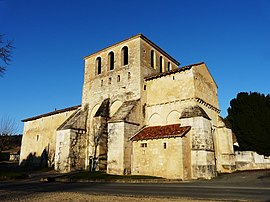Agonac
Appearance
Agonac | |
|---|---|
 The church in Agonac | |
| Coordinates: 45°17′36″N 0°45′03″E / 45.2933°N 0.7508°E | |
| Country | France |
| Region | Nouvelle-Aquitaine |
| Department | Dordogne |
| Arrondissement | Périgueux |
| Canton | Trélissac |
| Intercommunality | Le Grand Périgueux |
| Government | |
| • Mayor (2020–2026) | Christelle Boucaud[1] |
Area 1 | 37.22 km2 (14.37 sq mi) |
| Population (2022)[2] | 1,809 |
| • Density | 49/km2 (130/sq mi) |
| Time zone | UTC+01:00 (CET) |
| • Summer (DST) | UTC+02:00 (CEST) |
| INSEE/Postal code | 24002 /24460 |
| Elevation | 110–224 m (361–735 ft) |
| 1 French Land Register data, which excludes lakes, ponds, glaciers > 1 km2 (0.386 sq mi or 247 acres) and river estuaries. | |
Agonac (French pronunciation: [aɡɔnak]) is a commune in the Dordogne department in Nouvelle-Aquitaine in southwestern France. It is situated on the small river Beauronne, 12 km (7.5 mi) north of Périgueux. Agonac station has rail connections to Bordeaux, Périgueux and Limoges.
Population
[edit]| Year | Pop. | ±% p.a. |
|---|---|---|
| 1968 | 1,162 | — |
| 1975 | 1,027 | −1.75% |
| 1982 | 1,059 | +0.44% |
| 1990 | 1,342 | +3.00% |
| 1999 | 1,451 | +0.87% |
| 2007 | 1,612 | +1.32% |
| 2012 | 1,690 | +0.95% |
| 2017 | 1,761 | +0.83% |
| Source: INSEE[3] | ||
History
[edit]The settlements "Borie-Vieille" and "Les Cadagnes" have yielded prehistoric remains.
In the 11th century, the village was built on a hill controlling valleys with difficult access. Agonac was one of four fourtresses and protected the area from the Norman invasions.
See also
[edit]References
[edit]- ^ "Répertoire national des élus: les maires". data.gouv.fr, Plateforme ouverte des données publiques françaises (in French). 2 December 2020.
- ^ "Populations de référence 2022" (in French). The National Institute of Statistics and Economic Studies. 19 December 2024.
- ^ Population en historique depuis 1968, INSEE
Wikimedia Commons has media related to Agonac.



